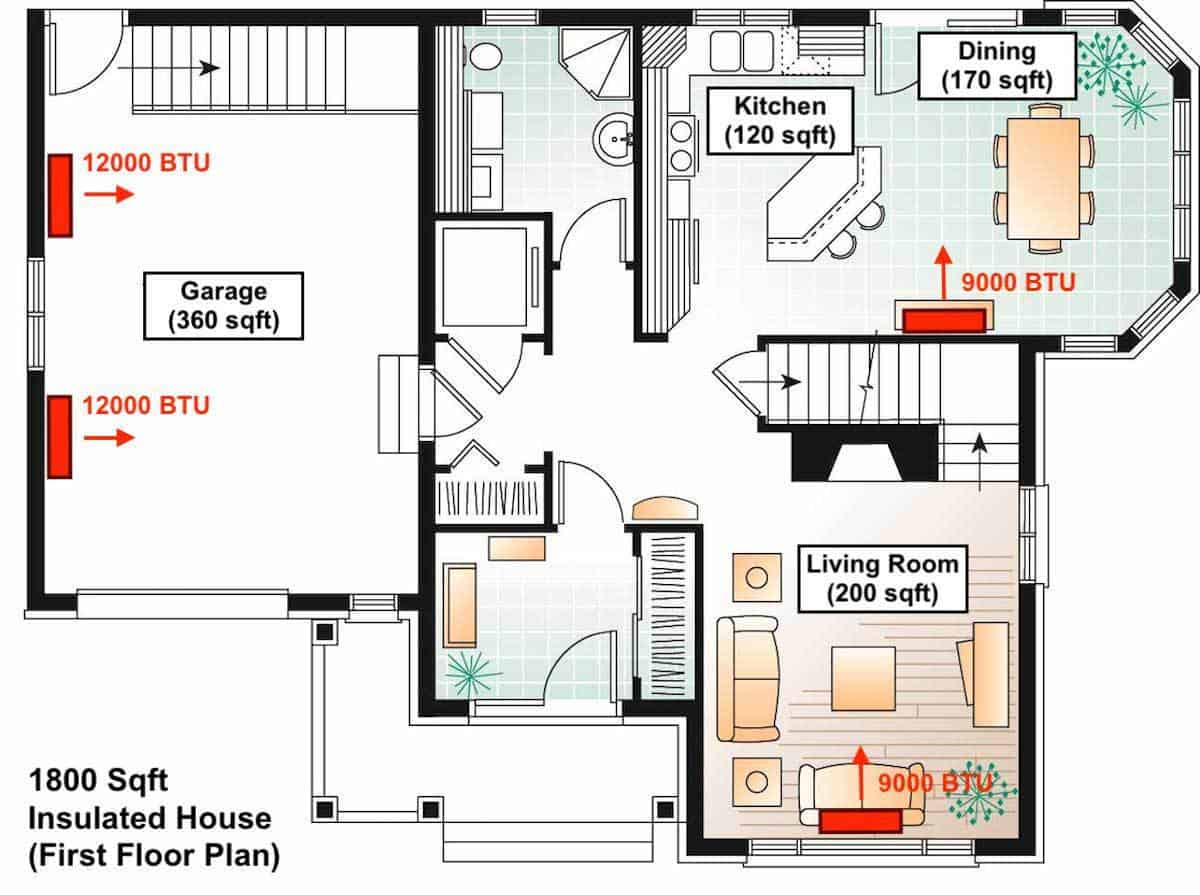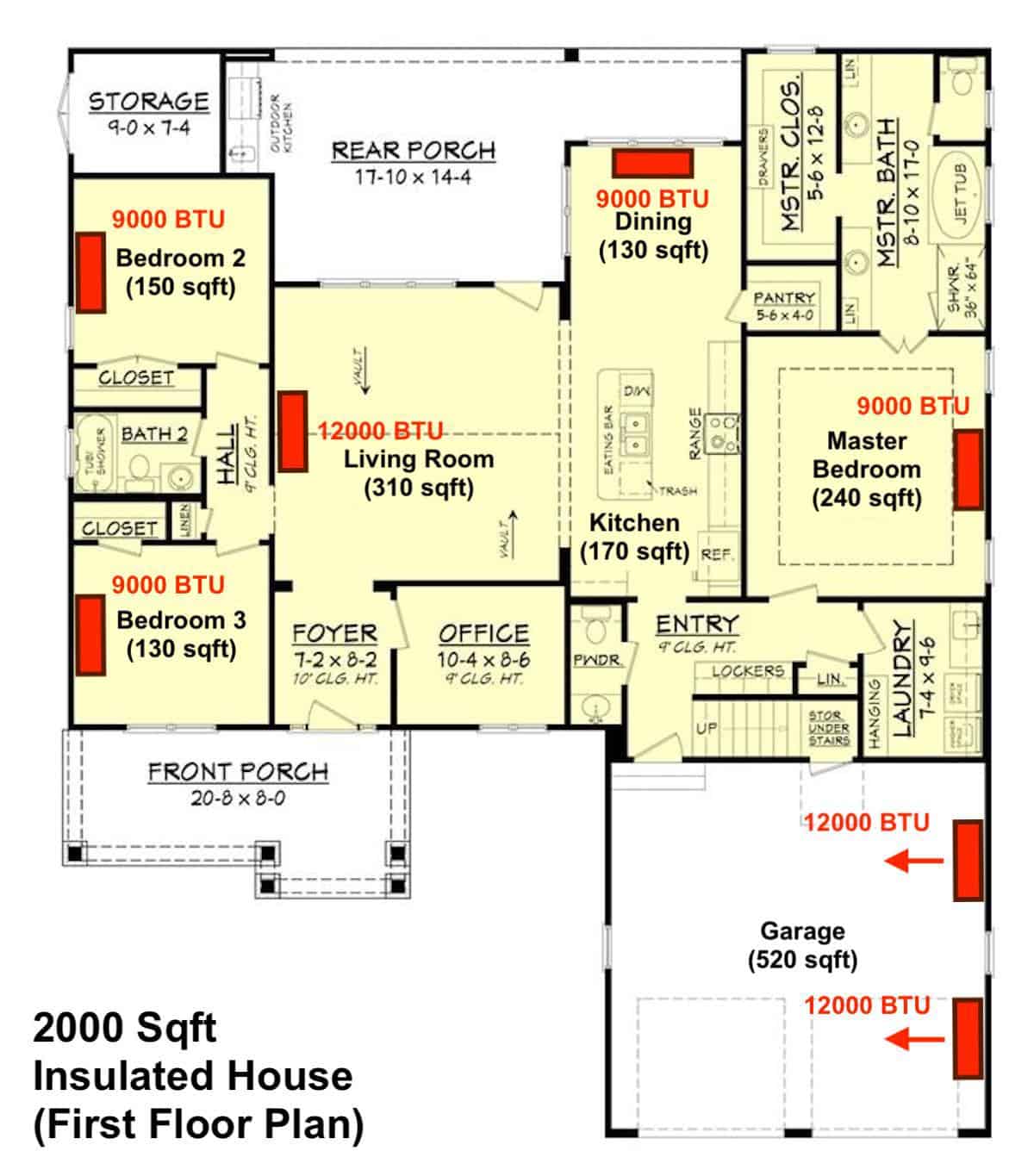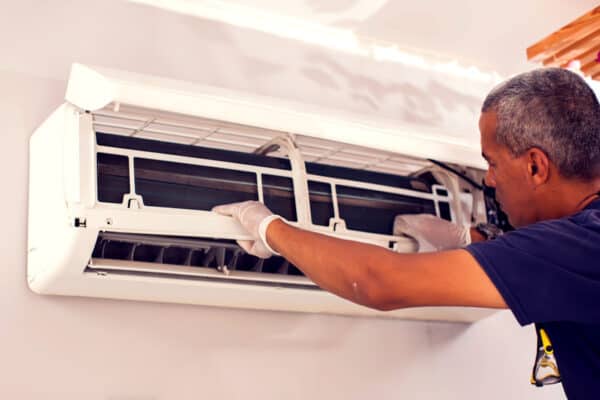Mini Split Sizing Guide: How-to, Chart & Example
Mini splits are only available in a few sizes. The largest mini split often only has a cooling capacity of 24000 BTU. Hence, traditional room air conditioner sizing charts may not be applicable. So, how do you calculate the size of a mini split?
To determine the size of a mini split, calculate the square footage of the room and multiply it by 25 to obtain the cooling capacity needed in BTU. Then, select the nearest mini split size based on the calculated BTU.
For instance, a 500 sqft room requires a 12000 BTU mini split because 500 sqft multiplied by 25 is 12500 BTU and the nearest mini split size is 12000 BTU.
As a rule of thumb, we use about 25 BTU per square foot to calculate the cooling capacity needed for a room. Because mini splits have several fixed capacities, we have to select the one that matches our needs.
But, we don’t always need to use a rule of thumb of 25 BTU per square foot. Generally, anywhere between 20-30 BTU per square foot is acceptable to be used to calculate the capacity needed for room air conditioners such as a mini split.
However, the rule of thumb of 20-30 BTU per square foot is meant for insulated rooms or houses.
So, if your room or house is not insulated or, the insulation is known to be in poor condition, you need to double the rule of thumb figure or use 40-60 BTU per square foot to calculate the capacity needed thereby choosing the right mini split size.
In Malaysia (where I live), we usually use around 60 BTU per square foot to determine the cooling capacity needed for a room because houses here are not insulated. Then, we proceed to select a suitable mini split size.
In the past few years, air conditioners only have fixed-speed compressors. Nowadays, most air conditioners including mini splits are equipped with variable-speed compressors or technically known as inverter compressors.
With inverter technology, mini splits are capable to operate in a range of capacity rather than a fixed capacity. For instance, a typical 9000 BTU mini split can operate anywhere between 4500-10500 BTU.
Inverter technology allows us to have more tolerance on the calculation of the cooling capacity needed for a room.
Therefore, if you happen to install a mini split with slightly more capacity than the room needs, you have nothing to worry about because the mini split will reduce its cooling/heating power accordingly to maintain a comfortable room temperature while saving power.
With that said, let’s take a look at the general capacity needed for different room sizes as well as my recommended mini split size and quantity.
Mini Split Sizing Chart
Since we can use any figure between 20-30 BTU per square foot to determine the capacity needed for a room, I use an average of 25 BTU per square foot as a baseline for easy understanding.
Room Air Conditioner Capacity Needed
The following table is the cooling capacity needed for multiple common room sizes. Take note that it is for individual rooms or spaces, not the entire house. For an entire house, the figure will be different.
| Room Size | Capacity Needed |
|---|---|
| 200 sqft | 5000 BTU |
| 300 sqft | 7500 BTU |
| 400 sqft | 10000 BTU |
| 500 sqft | 12500 BTU |
| 600 sqft | 15000 BTU |
| 700 sqft | 17500 BTU |
| 800 sqft | 20000 BTU |
| 900 sqft | 22500 BTU |
| 1000 sqft | 25000 BTU |
| 1100 sqft | 27500 BTU |
| 1200 sqft | 30000 BTU |
| 1500 sqft | 37500 BTU |
| 2000 sqft | 50000 BTU |
As mentioned earlier, the above capacity figures are based on an average of 25 BTU per square foot. If you think that your room has a lot of shade and is not very hot, you can use 20 BTU per square foot.
However, whether it is 20 BTU per square foot or 25 BTU per square foot, it can sometimes be irrelevant because we still need to select a mini split size with a fixed capacity anyway.
That’s why I created the following charts as a guideline for what size of mini split you need and how many quantity of mini split you need for different sizes of room.
By the way, if you want to learn more about mini split especially how to design it for your house, consider my Mini Split (eBook). You’ll learn what is Mini Split, how to choose and more importantly, spark more design ideas to improve the energy efficient of your house. But, if you need a second opinion or want someone to help you design, then you can consider my consultation service.
Consultation Service
Ask me for HVAC advice such as brand selection, best model, benefits, features, placement, duct size, grille size, how to design, design check, verification and other HVAC related queries.
Mini Split Size and Quantity for Insulated Rooms
In countries like the United States, most single-family houses are built with insulation. Thus, they don’t require as much of a cooling capacity as houses in countries like Malaysia and Singapore where almost all houses are not insulated.
So, if your room or house is INSULATED, the following is the recommended mini split size and quantity:
| Room Size | Capacity Needed | Mini Split Size | Mini Split Qty |
|---|---|---|---|
| 200 sqft | 5000 BTU | 9000 BTU | 1 |
| 300 sqft | 7500 BTU | 9000 BTU | 1 |
| 400 sqft | 10000 BTU | 12000 BTU | 1 |
| 500 sqft | 12500 BTU | 12000 BTU | 1 |
| 600 sqft | 15000 BTU | 18000 BTU | 1 |
| 700 sqft | 17500 BTU | 18000 BTU | 1 |
| 800 sqft | 20000 BTU | 24000 BTU | 1 |
| 900 sqft | 22500 BTU | 24000 BTU | 1 |
| 1000 sqft | 25000 BTU | 12000 BTU | 2 |
| 1100 sqft | 27500 BTU | 12000 BTU | 2 |
| 1200 sqft | 30000 BTU | 18000 BTU | 2 |
| 1500 sqft | 37500 BTU | 18000 BTU | 2 |
| 2000 sqft | 50000 BTU | 24000 BTU | 2 |
As you might have noticed already, large rooms start to need more than one mini split. This is because the largest mini split is 24000 BTU for most brands.
Indeed, certain brands offer mini splits with a cooling capacity higher than 24000 BTU (eg: 36000 BTU and 48000 BTU) but they are uncommon and much more expensive.
So, it is almost always better to use more mini splits with a lower capacity than using one mini split with a higher cooling capacity for large rooms.
Furthermore, there is a limit to how far the airflow of a mini split can reach. So, even if you use one large mini split that has sufficient capacity, the space far away from the mini split may still feel hot.
Therefore, large rooms should use two to three smaller capacity mini splits to achieve balanced cooling/heating and maintain a comfortable room temperature.
Mini Split Size and Quantity for Non-Insulated Rooms
In countries like Malaysia and Singapore, houses are not insulated. As a result, heat gain is greater and thus, the cooling capacity needed is greater as well.
So, if your room or house is NOT INSULATED, the following is the recommended mini split size and quantity:
| Room Size | Capacity Needed | Mini Split Size | Mini Split Qty |
|---|---|---|---|
| 200 sqft | 10000 BTU | 9000 BTU | 1 |
| 300 sqft | 15000 BTU | 12000 BTU | 1 |
| 400 sqft | 20000 BTU | 18000 BTU | 1 |
| 500 sqft | 25000 BTU | 24000 BTU | 1 |
| 600 sqft | 30000 BTU | 12000 BTU | 2 |
| 700 sqft | 35000 BTU | 18000 BTU | 2 |
| 800 sqft | 40000 BTU | 18000 BTU | 2 |
| 900 sqft | 45000 BTU | 24000 BTU | 2 |
| 1000 sqft | 50000 BTU | 24000 BTU | 2 |
| 1100 sqft | 55000 BTU | 18000 BTU | 3 |
| 1200 sqft | 60000 BTU | 18000 BTU | 3 |
| 1500 sqft | 75000 BTU | 18000 BTU | 4 |
| 2000 sqft | 100000 BTU | 18000 BTU | 6 |
Mini Split Sizing Guide for Specific Applications
Certain applications may require you to size a mini split differently. Since they are more specific, I have a separate guide for each application:
Mini Split Size for Cold Climates
One of the most common mini split sizing problems is when used in cold climates. There is a category of mini splits that is meant for cold climates. These mini splits have names such as arctic, low ambient heating mini split and hyper-heating.
If the outdoor temperature in your place can fall near to the freezing point, you should use a cold climate mini split. Otherwise, you may not have sufficient heating even though you’ve sized the mini split perfectly.
To learn more about mini split in cold climates, see my post Do Mini Splits Work in Cold Weather Climate Effectively?.
How to Calculate the Size of a Mini Split?
I’ve mentioned quite a few things related to mini split sizing in the above. Now, let’s recall and summarize them in the following:
1. Determine the capacity needed
Calculate the square footage of your room and multiply it by 20-30 BTU per square foot to determine the capacity needed if your room or house is insulated. Use 40-60 BTU per square foot instead if your room or house is not insulated.
Capacity Needed = Room Square Footage x BTU per Square Foot
Modern mini splits have inverter technology that enables them to operate in a range of capacity. It allows us to have more tolerance on mini split sizing.
Hence, the BTU per square foot figure doesn’t have to be perfect. Besides, mini splits have several fixed capacities anyway. So, just estimate the capacity needed and move on to the next step.
2. Select the nearest mini split size
Once you have determined the capacity needed, select the nearest mini split size based on the available model. Usually, mini splits have the following cooling capacities:
| Mini Split Size | Equivalent Size | Equivalent Size | Equivalent Size |
|---|---|---|---|
| 9000 BTU | 0.75 Ton | 2.5 kW | 1.0 HP |
| 12000 BTU | 1 Ton | 3.5 kW | 1.5 HP |
| 18000 BTU | 1.5 Tons | 5.0 kW | 2.0 HP |
| 24000 BTU | 2 Tons | 7.1 kW | 2.5 HP |
In countries like the United States and the United Kingdom, the capacity of mini splits is rated in BTU. In countries like Malaysia and Singapore, the capacity of split air conditioners is rated in HP or horsepower.
In countries like Australia and Japan, the cooling/heating capacity of split systems is rated in kW or kilowatt (not the kW for power). In countries like India and Thailand, the capacity of split air conditioners is rated in Ton or RT or refrigeration tonnage.
The capacity of air conditioners can be converted as follow:
- 3412 BTU equals 1 kW
- 1 Ton equals 12000 BTU
- 9000 BTU equals 1 HP
3. Use more than one mini split for large rooms
It is better to use more than one mini split for a large room because there is a limit to how far the airflow of a mini split can reach.
Generally, if the length of space that needs cooling/heating exceeds 10 meters or 32 feet, you should use put one more mini split in the opposite direction. Besides, if your room has a rectangular shape, you may also need to use more than one mini split.
It’s difficult to explain in words and so, let’s take a look at some examples as follows:


From the above examples, you can see that I recommend two mini splits for the garage. It’s because the garage usually has a lot of heat gain. Furthermore, the garage is wide and long.
So, it is better to have two mini splits to cool the garage evenly. For other rooms, a 9000 BTU or 12000 BTU mini split will be sufficient.
The positioning of the mini split is extremely important. Wrong mini split placement can lead to all sorts of performance issues. For that, I strongly suggest you read my post Best Place to Put the Mini Split Air Handler and Condenser.
Factors that Affect the Size of a Mini Split
Further to the above mini split sizing calculation, there are a few factors that can cause a mini split size to exceed 30 BTU per square foot for insulated rooms or houses.
- Exceptionally strong solar heat gain through windows – If your room or house has full-height windows that you don’t prefer shade with curtains/blinds, you may want to use 35-40 BTU per square foot to accommodate for the extra heat.
- Extra numbers of people at once – If you plan to hold a lot of people at once in your room or house (eg: a Christmas party, probably around 15-20 pax), you may want to use 35-40 BTU per square foot to accommodate for the extra heat. However, you don’t always throw a party and thus, you may put a 9000 BTU mini split separately and turn it on only when you have a party.
- Low outdoor air temperature – Mini splits are designed based on an outdoor temperature of 95℉ (35°C). Hence, if the outdoor temperature in your place hardly reaches 90℉ (32°C), you can use a smaller capacity mini split and vice versa.
- Ceiling height is more than 10 feet – If you have a high ceiling room, increase the capacity needed by 10%.
What Happen If You Oversize a Mini Split?
As mentioned earlier, if you use a mini split with slightly more capacity than the room needs, you are usually fine because mini splits can regulate their capacity based on the needs.
For instance, you’re fine using a 9000 BTU mini split in a 150 sqft small bedroom that may only need about 4500 BTU of cooling capacity because it can operate at around 4500 BTU.
Besides, you’re also fine using an 18000 BTU mini split in a 500 sqft living room that may only need 15000 BTU of cooling capacity because it can operate anywhere between 5500 BTU and 20000 BTU.
Following is the range of operating capacity of a typical mini split:
| Rated Capacity | Minimum Capacity | Maximum Capacity |
|---|---|---|
| 9000 BTU | 4500 BTU | 10500 BTU |
| 12000 BTU | 4500 BTU | 13500 BTU |
| 18000 BTU | 5500 BTU | 20000 BTU |
| 24000 BTU | 6000 BTU | 27500 BTU |
Generally, it is acceptable to use a one-size-bigger mini split. However, if you happen to use a mini split that is two or three-size-bigger, you may run into high humidity problems.
When your room or house needs a 9000 BTU mini split and you choose to use a 12000 BTU mini split, it is considered one size bigger and you should be fine. But, if you decide to use an 18000 BTU or even a 24000 BTU, you have the risk of high humidity and overcooling problems.
Do You Need a Mini Split in Every Room?
For every room that needs heating and cooling, a mini split is inevitable. However, if you really want to share a mini split with multiple rooms, you need to use a ducted mini split.
Ducted mini splits are similar to a central air conditioner. They are required to be connected to a duct and discharge air through diffusers. See more about ducted mini split in my post Ducted Mini Split Guide: Basics, Comparison & Installation.
Conclusion
It’s important to put the right size mini split in your room or house. Oversized mini splits may cause overcooling and high humidity issues. Undersized mini splits obviously will cause insufficient cooling. Hence, we should always pay extra attention to mini split sizing.
Lastly, consider my Mini Split (eBook) if you want to know how can you use Mini Split in your house. If you still have doubt or not feeling confident enough, feel free to consult me.
Consultation Service
Ask me for HVAC advice such as brand selection, best model, benefits, features, placement, duct size, grille size, how to design, design check, verification and other HVAC related queries.
If you have anything to add (or ask) about this topic, leave a comment down below!








